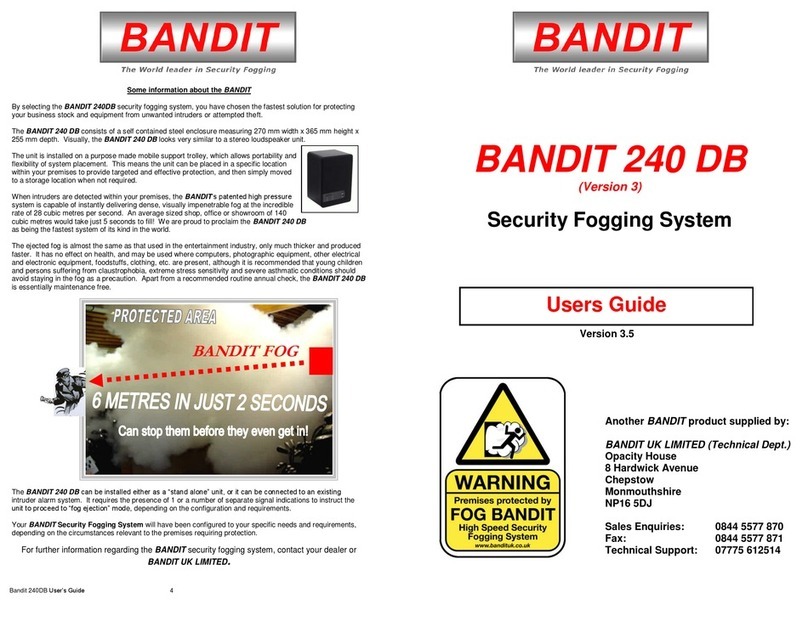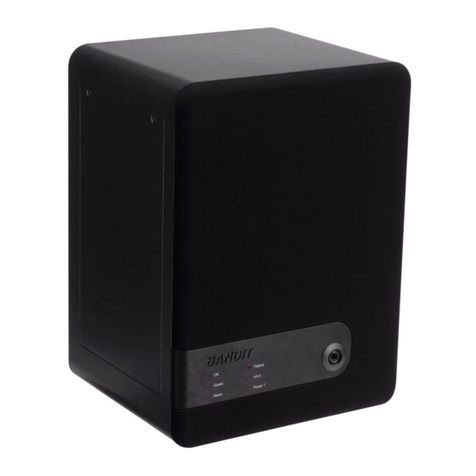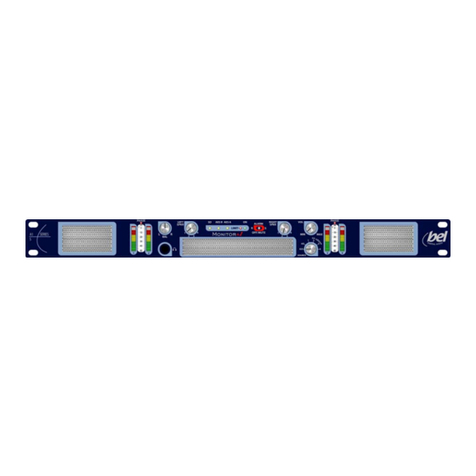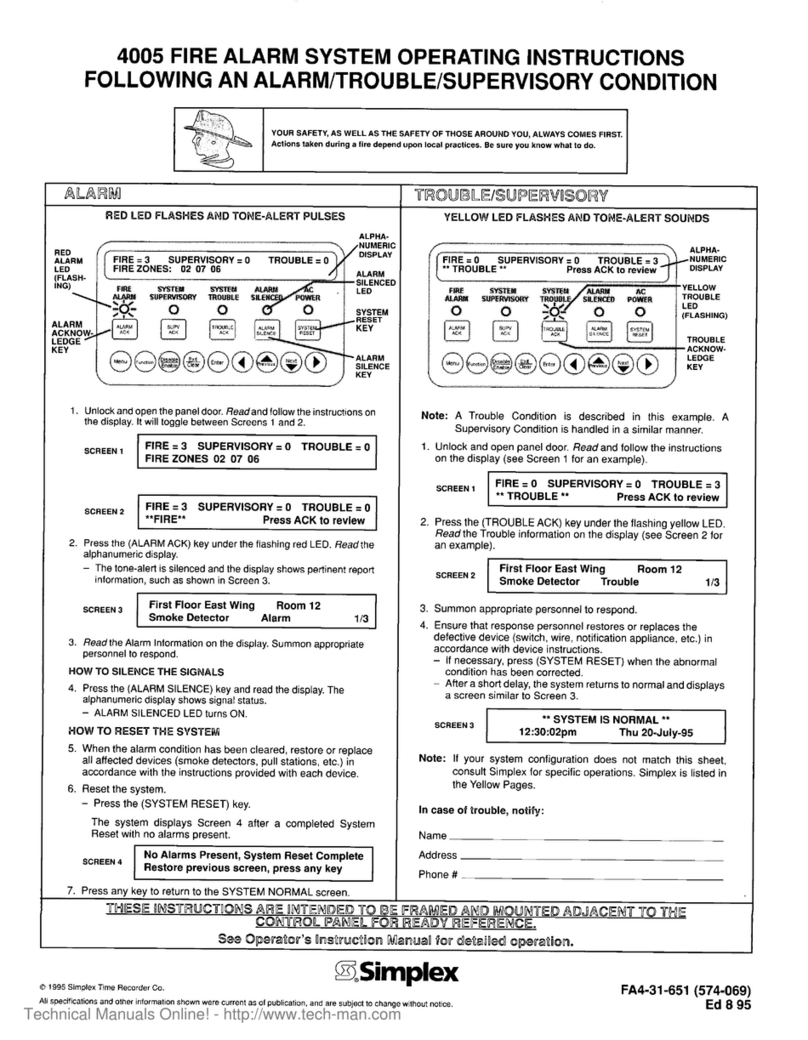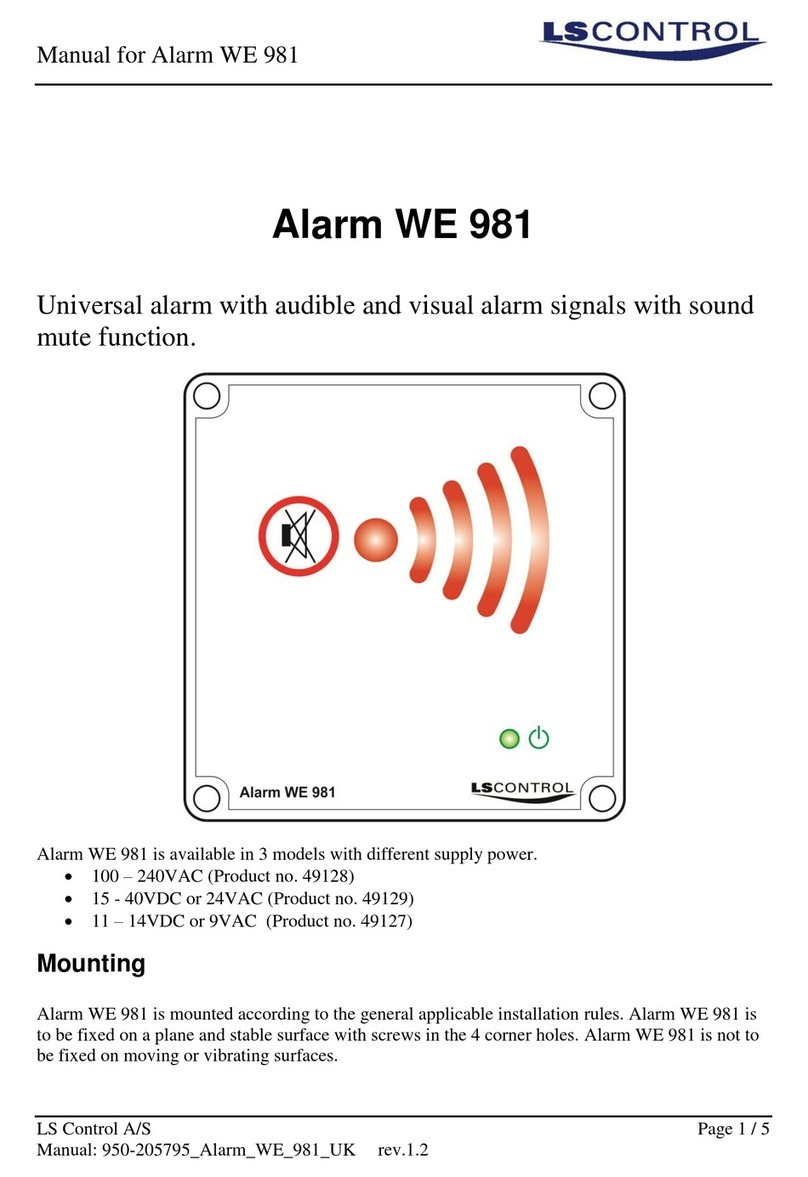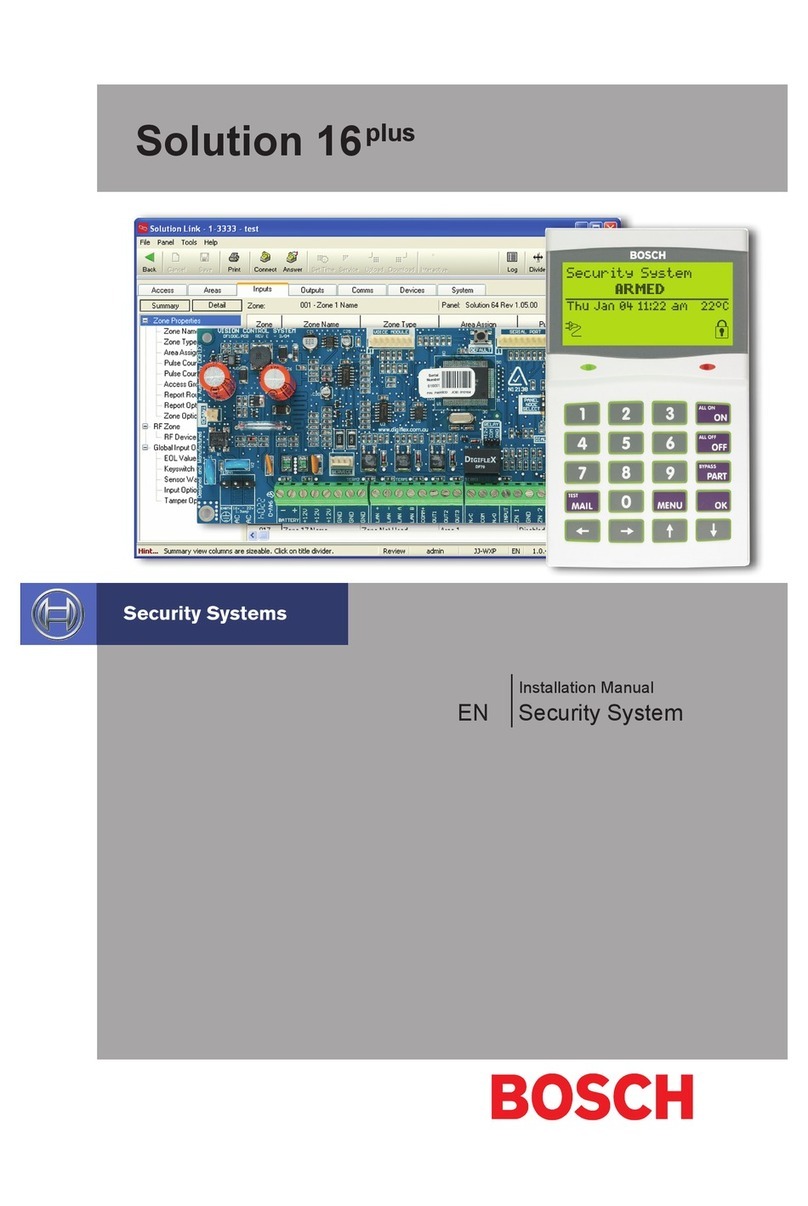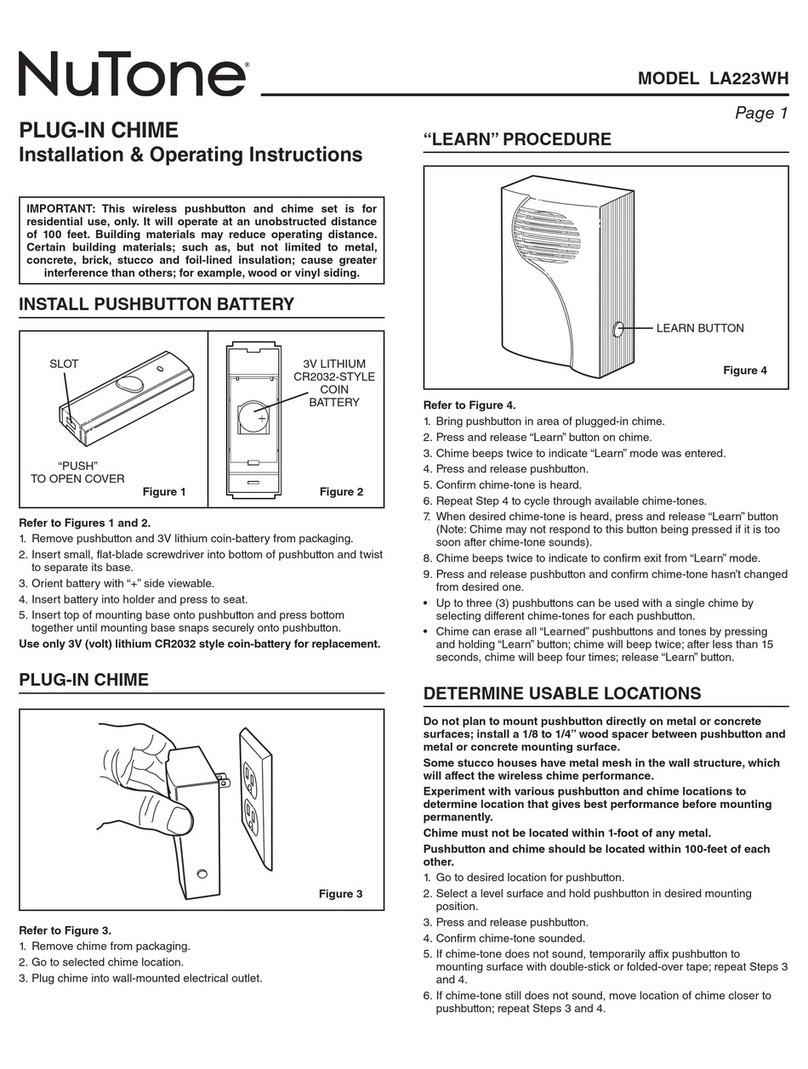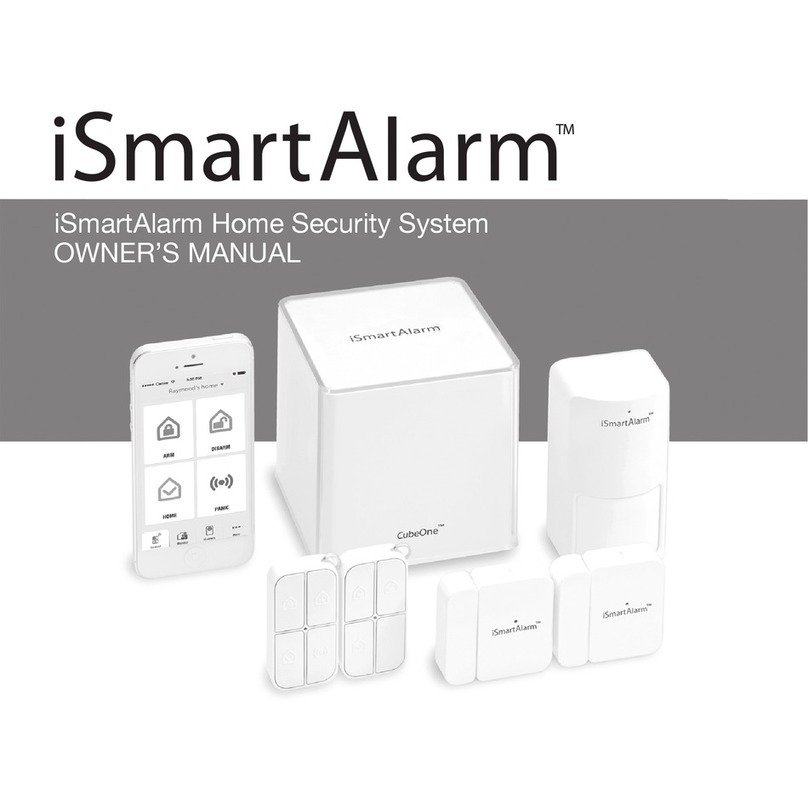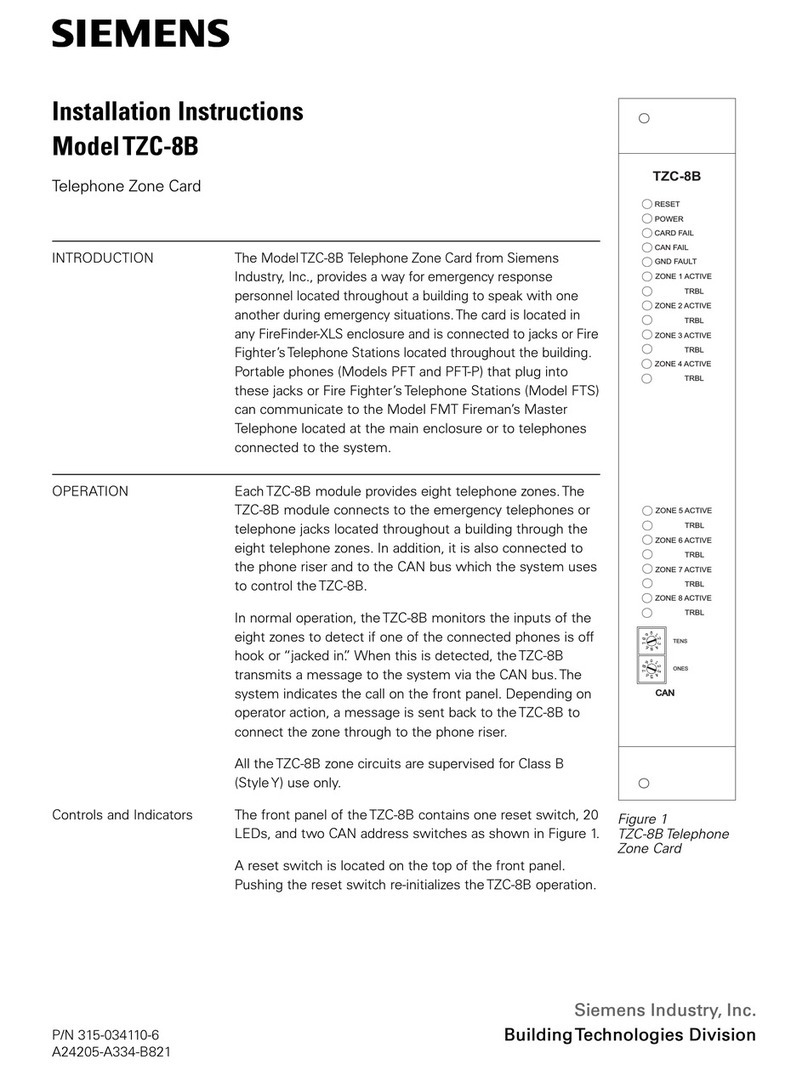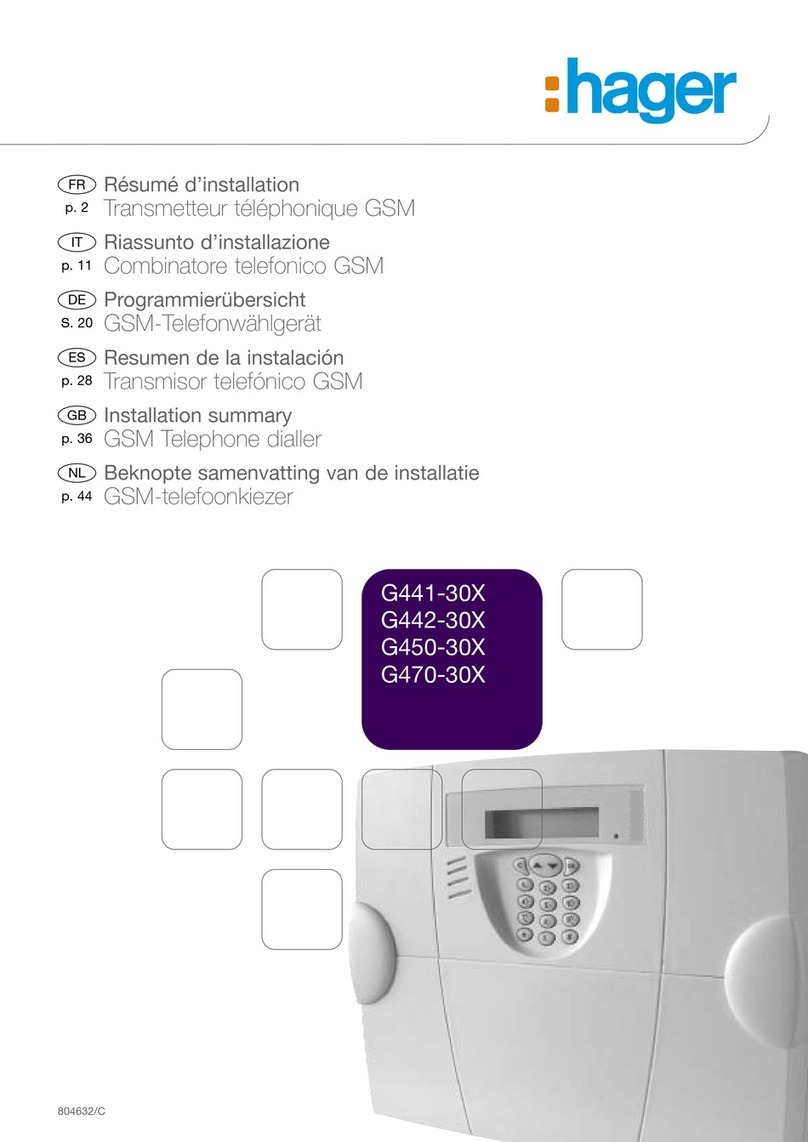Band-it 240 PB User manual

Introduction ........................................................................................................page 01
Safety precautions ......................................................................................................03
Mounting ......................................................................................................................05
Electrical connection......Main power..........................................................................
PCB layout .........................................................................09
Inputs...................................................................................10
Outputs................................................................................22
Status communication ...Front LEDs...........................................................................32
Audio ...................................................................................35
Event-log ......................................................................................................................37
Passwords ...................................................................................................................38
Control Box ................................................................................................................39
HY3-pack replacement ...............................................................................................41
Maintenance.................................................................................................................43
First aid .......................................................................................................................44
Schematic examples ...............................................45
Specifications ..............................................................................................................04
08
Frequently asked questions &
BANDIT 240PB Installation manual v.408
World leader in
active security
INSTALLATION MANUAL
ONTENTS
BANDIT 240PB
C
UK 230 VAC

BANDIT 240 PB v.408
Introduction - p. 1
INTRODUCTION
By selecting this device, you have acquired advanced active access-prevention technology.
With BANDIT we offer you an affordable system which guarantees operational reliability, top
performance and a discrete design.
More and more private and public buildings are being equipped with a protection system
against burglary. When armed, these systems detect a burglary attempt. The detection is
generally communicated by means of a siren and/or strobe or sometimes an automatic
phone call to an alarm control centre or police station. In real terms these notifications are
satisfying, but the subsequent human intervention often arrives more than 10 minutes
after the event! Burglars are aware of this and use this time to steal the most valuable
things and get away in time.
BANDIT offers a unique and active solution to this problem. For this system is totally capable
of filling a large office, store or other room, within a few seconds, with a non transparent fog.
This fog prevents persons from entering the room for at least 10 minutes after setting off the
alarm, since they cannot see a thing. The ejected fog has a soft mint smell (to avoid possible
fire interpretation by outsiders), it is colourless and leaves no traces. So the fog safely and
quickly disables the vision capabilities of unwanted visitors.
BANDIT is installed in those rooms that contain the most valuable objects; by doing so,
burglary damage is effectively limited to a strict minimum.
Advantages:
- Fills 1000 Ft³ (28 m³) of space per second of fog expulsion.
- Extremely compact and discrete design.
- A system free of maintenance with very high operational reliability (by lack of moving
components).
- The standard integrated “Power saver” and good thermal isolation, maintains a very
low energy consumption, between 30 and 40 W/h, depending on the adjusted fog
expulsion period.
- Continuous control of liquid level. When the level is too low to guarantee a full
expulsion period it will be shown by an LED and an electrical contact will occur. In this
case you’ll have to replace the internal HY-3 pack. The recognition and acceptance of
the new HY-3 pack (such as the resetting of the HY-3 shortage notification), occur
automatically. For recharging, the empty HY-3 pack has to be returned to your BANDIT
dealer.
- In case of interrupted power supply voltage (230 VAC), operation is guaranteed:
electronics ~24 hours, fog generator ~2 hours.
- The device is prepared through plug-in connectors, to be extended with a control box
and/or a wireless remote control.
- A powerful and flexible alarm central connection. With this the unit can be programmed
by means of a PC/laptop (Win95/98/2000/XP). This kind of programming facility offers
a comfortable and practically unlimited programming possibility.
- Includes a ‘real time clock’ and extended log for 1000 events, whereby every event is
documented with time and description of it. This electronic log is equipped with an
internal battery (10 years), in order to save all data in the event of a total power failure
occurs.

BANDIT 240 PB v.408
p. 2 - Introduction
- The internal failure check system constantly controls the perfect operation of:
- the internal power fuses and heat fuses
- the power voltage of the 13,2 volt battery
- the communication with the HY-3 pack
- the status of the inputs and outputs
- the temperature of the heat exchanger, the HY-3 pack, and the PCB environment.
- the presence of power supply voltage.
- the internal tamper circuit (anti-sabotage circuit).
- By means of a connecting cable (communication link) between a IBM compatible PC or laptop,
you will be able to read out the unit (settings, log and/or internal values). The required CD with the
Bandit Software can be requested for free at your local BANDIT dealer, or can be downloaded from
our web site www.bandit.be. This program runs with Win95, 98, 2000 as well as with XP and offers
a friendly Windows like users program.
It is advised to perform a yearly fog generator test. See also Maintenance, page 43.
Standards:
- Complies with European CE and EMC Standards.
- Complies with International Standard: IEC 839-1-3
- Approved by the Belgian Ministry of Internal Affairs
- Complies with the British Standard: BS 7939 : 1999
- Complies with the Dutch Standard of the NCP: IOE 03301-M and IQA 06901-M
- Complies with the French Standard of the CNPP: test report n°AI 040006
approval n° 2004-0001
- Complies with the Danish Standard of the F&P: class 1, AIA 212
registration n° 10.212-00418
Industrial property:
- BANDIT is a registered trade mark.
- HY-3 is a registered trade mark.
- The BANDIT fog generator process is internationally protected by several patents.
CText and drawings in this document are subjected to author protection.
Copyright: BANDIT NV, B-3660 Opglabbeek, Belgium.
Producer:
BANDIT nv./sa. H. R. Tongeren: 78.324
Nijverheidslaan 1547 : (32) 89 85 85 65
B-3660 Opglabbeek Fax : (32) 89 85 23 64
Belgium web : www.bandit.be
((

Safety precautions - p. 3
SAFETY PRECAUTIONS
Location:
- To prevent fire or shock hazard, do not expose this appliance to rain or moisture.
- Install the device in such a way to allow a good airflow.
- Only install the appliance as described, i.e. In vertical position, with the text on the
front panel being readable from the floor. The maximum angle of inclination is 15° to
the front and 10° in all other directions.
- System malfunction is possible at ambient temperatures above 50°C. Keep the appliance
away from heat sources such as radiators, heating elements, stoves or other heat
producing devices.
- The appliance is unexpectedly heavy, ~62 Lbs (28 Kg). It needs to be fixed on a sufficiently
solid surface. Use sufficiently strong fixing materials, preferably our 240 floor or wall
mounting, which are very solid and reliable supports for your unit.
Electrical connection:
- This appliance only operates on 230 VAC / 50 - 60Hz (210-240 VAC) supply voltage with
grounding. Always check the voltage on the rear cover of the device.
- This device has a max. Peak consumption of 3.5 A / 230 VAC. Use only power cable and
grounding of minimum 1.5 mm² (preferably flexible with end splices). Use the strain
relief which is ~0.5 In. beneath the entrance of the power supply input.
- If you detect a strange smell or smoke, the appliance has to be switched off immediately
by turning the main supply fuse to “off”.
- In case of doubt, immediately contact your BANDIT dealer or manufacturer, mentioned on
the back cover of this manual.
- There are no repairable components inside the appliance. Leave all repairs to authorised
persons and/or the manufacturer.
- The PCB contains a heat sink. On all parts and areas beneath and around this cooling
plate, there are uninsulated “dangerous voltage” points. This “dangerous voltage” can
cause electrical shocks.
- For further connection instructions, see page 8.
Cleaning:
- Do not use volatile fluids, such as alcohol, thinner, petrol or spirit to clean the outside
of the appliance. Use a clean, damp cloth.
- The black front textile has to be cleaned with a vacuum cleaner with soft brush mouth (dust
signs). The frequency of cleaning depends on the quantity of dust present in the room to be
secured.
Fog ejection control:
- The ejection nozzle is normally about 5°C warmer than the temperature of the environment,
so not warm enough to get burned by. However during fog ejection and the first two minutes
after, this nozzle can reach a temperature up to 120°C . Avoid direct contact with the nozzle
after a fog ejection to prevent skin burns.
- A fog ejection test only should be performed when:
a) All persons in the surrounding area and fire safety personnel have been notified, and
b) There is nobody in the immediate surroundings and/or direction of ejection.
- During a fog ejection test, it is prohibited to look towards the direction of the ejection nozzle
from a distance less than 25 Ft (8 metres).
BANDIT 240 PB v.408

p. 4 - Specifications
SPECIFICATIONS
Descriptions:
- Dimensions:
- Weight:
- Max. Mains supply failure:
- Reaction time:
- Fog ejection image:
Fog generator:
- Fog ejection capacity:
- Fog ejection pressure:
- Maximum fog ejection period:
- Warm-up time:
- Max./min. Environmental temp.:
- Maximum heat loss:
- Heat exchange capacity:
- Nominal ejected droplet size:
HY-3 pack:
- HY-3 fluid contents:
- Nominal working pressure:
- Maximum allowed internal pressure:
- Construction material:
- Build-in electronics:
Electrical:
- Min./max mains power supply:
- Nominal 12 V low voltage:
- Max peak current at 230 VAC:
- Average power consumption:
- Capacity heating element:
- Inputs:
- Outputs:
- Current back-up:
- Power control:
- Electronics:
10.6 In. wide x 14.4 In. high x 10 In. deep.
62 Lbs (28 Kg).
Fog generator +2 hours and electronics +24 hours.
1 second between alarm signal and fog ejection.
Cone shaped straight ahead (optional), or
1000 Ft³ filling of space / second with 1 Ft. eye object.
230 PSI (1.6 Mpa).
18 seconds.
50 minutes from cold condition.
maximum 50°C / 120°F and minimum 0°C / 30°F.
40 W/hour.
18 kW/hour.
section 0,000016 In. / 0.004 mm (full aerosol).
1.4 litre (0.37 gal.).
230 PSI (1.6 Mpa).
870 PSI (6 Mpa).
rvs 304L and aluminum AlMgS1.
digital temperature sensor and analog/digital
E²prom memory level.
tamper switch and control LED.
integrated propellant-expulsion security
direct working 12 V NC valve.
210 to 240 VAC at 50 to 60 Hz.
13.1 V DC from 0 tot max. 500mA load.
3.5 Amps.
40 W/hour.
750 W.
all inputs are insulated by an opto-coupler.
all outputs are potential free relais contacts
12 V / 2 Ah (sealed lead acid battery).
Pulse width modulator (PWM) through zero-cross triac.
Flash micro-controller, Platina Pt1000 sensor converter,
time/date clock with back-up battery and 64K E²prom.
On board communication with HY-3 pack
On board communication: 6-way connector for
connection to "Control Box" and 5-way plug for
wireless remote control.
Serial communication with communication link
BANDIT 240 PB v.408
(R60 standard version)
60° wide coon

As a professional, you’ll have to consider properly, what would be the most effective place to
install the appliance. Here are some guidelines which can help you with your decision:
þ Logically, you’ll place the appliance so that the fog expulsion points in the direction of the
supposed burglary entrance or in the area which contains the most valuable objects.
Should this entrance provide a potential big air passage to outside (i.e. a garage door,
a glass frontage which is sensitive for break-in, etc.), You’ll have to prevent the ejection
nozzle being pointed in this direction to avoid the potential fog ejection to be blown
outside. In this case, you’ll have to point the nozzle towards a side wall to break the
ejection pressure. This way, the fog will “cloud out” and only a little amount of
fog will be blown directly to the outside.
þ Avoid the ejected fog forming a oneway trap. The ejected fog is supposed to form a
strong take-away reducing barrier. Burglars are not supposed to be caught.
Further, if there is a false alarm, the chance to catch innocent persons, is bigger than to
catch burglars in a real burglary!
þ Determine the place in such a way that the ejection nozzle does not point in the direction
of fragile objects. The powerful fog expulsion could blow down these objects.
þ There has to be a free passage area for the ejected fog, of at least 20 Ft. before it
bounces against a fog blocking obstacle, i.e. a front wall. The space of about 20 Ft. in
front of the ejection nozzle will be the first to be filled out with fog, and this within 2
seconds.
þ If there are already PIR-sensors installed in the
room to be guarded and you don’t want to take
any risks with false triggering because of fog
expulsion, you’ll have to replace these PIR’s
with combo-sensors (PIR/radar). If you have to
install a new installation, use combi-sensors for
volumetric detection in ereas where BANDIT is
installed. Radar never detects floating clouds,
most PIR’s do sporadically.
þ Make sure that no burglar can come near the
unit without being detected first by a sensor.
This sensor has to start a fog expulsion,
independently of an eventual entrance delay.
Mounting - p. 5
MOUNTING
The unit is packed in a cardboard box:
15.35 x 15.35 x 1.57 In. which contains:
- BANDIT 240 PB device.
- double sided warning sticker “Burglary...”
- this installation manual.
- "HY-3 grip" tool
Wall with
concealed
wiring or
groove
Ceiling
+ 2 . In
Appliance slightly
inclined forward ~ 5°,
maximum 15°
Keep a minimum of
1 Ft. of space at the
left hand side of the
unit,in order to open
the hatch to the
HY-3 pack.
BANDIT 240 PB v.408

þ Make sure the BANDIT is firmly secured to wall or floor, to prevent a burglar with prior
knowledge from throwing the unit quickly through a window.
Use an optional available BANDIT wallmounting to install the unit against a wall:
There are two kinds of wallmounting: flat or swivel. Use the re-usable mounting help
“Handy boy” to install the unit, as this tool carries the unit and makes it possible that any
person can install the device easily by himself.
- For wallmounting against a solid brick wall, use plugs and screws supplied within
- For wallmounting against a double plaster wall, use special metal plaster-plugs
available in any hardware store.
- For wallmounting against a single layer plaster wall: install the unit only in an inner
corner and order in addition an optional plaster inner corner support plate. Don’t install
the unit with a normal wallmounting against these kind of walls to avoid the device
falling on the floor after a while, due to its weight.
p. 6 - Mounting
þ For floor mounting, use BANDIT floor mounting. This floor mounting is screwed into the
floor or stuck to it with included double-sided adhesive tape. The device is installed at 2
In. (50 mm) off the floor to avoid possible damage due to cleaning tools or water.
Hidden mounting of the appliance
þ For installation into a closet, order the device with option /L. This unit is supplied with 4
rubber supports (feet), a 2 In. extended ejection nozzle (a standard closet door has a
thickness of approximately 3/4 In). and a heat resistant black door rosette (ejection
nozzle passage). This way you can hide the device and at the outside only the rosette
will be visible. Make sure you provide a ventilation grid above and beneath to avoid too
much rising of the temperature in the closet due to BANDIT ‘s heat loss. With an ambient
temperature above 50°C / 120°F, the unit will activate its technical output [Okout] and you
can expect damage on the internal lead battery.
F
BANDIT 240 PB v.408
Do not use any other rosette than the
one supplied with the unit. The supplied
rosette is made of a special heat and
steam resistant material. Fix the rosette
by using the special nut delivered with
it.
Hole drilled through
cabinet door
(hole saw dia. 2 In.)
Ejection nozzle, available
in R/60 or R/0 (straith) version
4 rubber feet
max. 1” (24 mm)
Black finish
rosette
Rosette
assembly nut
M50 x s. 1.5
Cabinet door
Cabinet schelf

p. 7 - Mounting
Mounting aid: handy boy.
This optional tool is used to install the device against a wall. It is attached with two pins to
the wall mounting and so it makes a solid shelf.
On this temporary shelf, BANDIT is wired and adjusted. After installation, the two pins
are pulled out, releasing the handy boy, so it can be used again in the next installation.
You’ll save yourself a lot of trouble to keep the device at a working height while connection
works are being performed.
Mounting more than one BANDIT 240 devices in one large room.
l
f
g
o
w
o
F
60 Ft.
115 Ft
Example of mounting in a shop of
6980 Ft². Fog image after 8 sec. of
fog expulsion.
l
f
g
o
o
w
F
33 Ft
60 Ft
Example of mounting in a shop of
1980 Ft². Fog image after 8 sec. of
fog expulsion.
The BANDIT 240 has a room filling capacity
of ~1000 Ft³ per second. This corresponds with
~100 Ft²/sec. The max. surface area which
can be secured with one device is equal to
the max. fog expulsion period = 18 s x 100 Ft²/s
which is 1800 Ft². For larger surfaces, such as:
large shops and office spaces, one has to
install more devices, one device each 1500 Ft²
with a normal ceiling height of 9 Ft. Install the units in such a way that the fog stream of one
device points next to, but not in the direction of the next unit. This way, there is a round stream
of fog throughout the entire place. This guarantees the fastest filling of the room.
While mounting, keep in mind to provide a free passage for the fog stream. After a while, the
store keeper has forgotten about the units and stacks boxes and displays right in front of the
fog ejector of the devices.
BANDIT 240 PB v.408

p. 8 - Connection to main power supply
ELECTRICAL CONNECTION
The BANDIT 240PB is equipped with simple and yet versatile interface. This version is only
programmable through PC or laptop using the communication link.
This unit is intended to be connected to an existing alarm system or be installed as a stand-alone
unit.
The build-in electronic system takes care of controlling and securing:
- the fog generator (3 x temperature + frequency control of valve).
- tamper switch of the rear cover, HY-3 pack hatch and optional connected "Control Box".
- control of front- and PCB LED, and internal siren.
- read out of inputs and jumper adjustments.
- control of tamper-, technical- and programmable outputs.
- control of internal battery, glass fuses and internal fan.
- digital and analogue communication with the HY-3 pack.
- serial communication with PC/laptop (com port)
The complete electrical system is accessible by removing the rear cover of BANDIT (unscrewing
4 x M4 cross head screw). The rear cover is tamper secured, so be sure that the unit is not in
guard mode and that the control room (optional) is warned.
Connection on the main power supply: on the left, beneath the PCB, you’ll find a
3 way terminal block with integrated main fuse. The PCB is marked with “230 VAC supply”.
Connect the left connector strip (N) to the mains neutral (blue or white wire), the middle one to
the green-yellow ground wire and the right connector (L) to the mains phase (black wire).
Switching phase and neutral has no effect to the function of BANDIT .
The unit is secured for mains failures and can be practically seen as an Ohmic power load.
Connect the power cable through the strain relief connector (~0.5 In. beneath the left entrance in
the metal back frame).
LN
Supply
230 VAC
Power supply
12 V
500 mA
+ -
Power supply glass fuse (5 x 20 mm)
F1 = 4 AT slow
- For complete PCB (printed circuit board) layout with description of connector strips, see page 9.
- For detailed description of
- For properties of the in and outputs, see page 10 through 31.
LED functions, see page 32 through 34.
- Preferably use a separate fuse, directly coming
from the main power supply or connect to
existing power circuit of installed controlling alarm
system (BANDIT has a peak current consumption
of 3.5 Amps. for each unit).
- For easy installing, use flexible connection wires
3 x 1.5 mm² with end splices.
BANDIT 240 PB v.206
F1 4AT

p.9 - PCB layout
PCB layout
BANDIT 240 PB v.408
LN
N
N
Prim. transfo
Sec. Transfo
Heater 750W
heatexchanger
230 VAC
Power supply
6.3AT
1.25AT
500mAT
F1 4AT
red
JMP
F2
F3
F4
Programmable
output n° 2
Programmable
output n° 1
Technical OK
output
Tamper loop
output [Tmpout]
Programmable
input n° 3
Programmable
input n° 4
Programmable
input n° 2
Programmable
input n° 1
12 VDC supply
(max. 500 mA)
Mains power supply
connection block with
integrated fuse (4 AT)
Mains power connecting
cable, min 1.5 mm²
12 V =
+ + + + + c c cc c c- - - - -
Supply Xin1 Xin2 Xin3 Xin4 Tmpout OKoutOKout Xout1 Xout2
X+ X+ X+ X+ Ta com com comnc nc ncnc nc ncno no nono no no
X- X- X- X- Tb
500 mA.
inputs: 12 V = / 10 mA. outputs: maximum 24 V / 1A.
Red
White
Green
Blue
Yellow
Black
6 x Control box
PCB connector
Remote control
PCB-connector
Real Time
Clock
click-on
battery
Yellow PWM
heating
Led
Non-touchable mains
voltage zone
Rear cover tamper
spring switch

P. 10 - Inputs
Inputs
opto
-+
ground
Schmitt-input
1 K
Aircoil
Scematic display of an input
All inputs are equipped with opto-couplers, which provide care of a perfect separation between
the internal BANDIT electronics and the “outside world”. This way, all unwanted disturbing
signals, caused by lightning, induction or R.F. tensions, are kept outside.
The device, model 240PB , is equipped with 4 inputs. The function is determined by selecting
the desired function trough PC/laptop.
Electrical properties of an input:
- polarised (+ and - signs beneath connectors on
PCB.
- secured for possible polarity reverse and equipped
with RC- and LC- filter.
- an input has to be stable for at least 0.2 seconds
before the new situation is accepted.
- the connected voltage can be either from an external
source or from the 12 V BANDIT supply source
itself [Supply].
- the input current with 12 V is ~ 10 mA each input.
- each input is equipped with a Schmitt-input, after
the opto-coupler. The trigger voltage is approximately
6 V with hysteresis of + and - 1V. This way,
unreliable input voltages are being avoided
as much as possible.
1
1
5
1
5
1
V =
After adjustments: check the voltage over
the inputs.
- Consider < 2 V as no volts.
- Consider > 9 V as 12 V .
Voltages between 2 and 9 V are not normal
and will cause problems sooner or later.
BANDIT 240 PB v.408
Programmable
output n° 2
Programmable
output n° 1
Technical OK
output
Tamperloop
output [Tampout]
Programmable
input n° 3
Programmable
input °. 4
Programmable
input n° 2
Programmable
input n° 1
12 VDC supply
(max. 500 mA)
12 V =
+ + + + + c c cc c c- - - - -
Supply Xin1 Xin2 Xin3 Xin4 Tmpout OKoutOKout Xout1 Xout2
X+ X+ X+ X+ Ta com com comnc nc ncnc nc ncno no nono no no
X- X- X- X- Tb
500 mA.
inputs: 12 V = / 10 mA. outputs: maximum 24 V / 1A.
Programmable inputs

p. 11 - Inputs - Functions
Possible software settings for the inputs.
On each of the four physical inputs [Xin1] to [Xin4], there can be assigned a function. To
simplify the human interpretation concerning the inputs while reading them out, each input
can be appointed with an alias (nickname) (e.g. [Xin2] = “PIR sensor entry”).
Following, you’ll find an overview of the possible settings, offered by the BS-software. In the
help-function of this BS-software, you’ll find more and detailed information for each function.
No function:
The input is totally ignored by the software.
Make a habit to assign a ‘no function’ to not connected inputs (floating).
This way you’ll make sure, this input is really ignored all the time.
Guard:
This function reports to that the selected input has been assigned as guard inputBANDIT
[Grdin]
The guard input arms/disarms the unit . Only if BANDIT is in "guard mode" is it possible to
switch to “alarm mode” by activation of the alarm input(s).
Properties of the "guard mode":
4The red LED "Guard" on the front panel will be on as long as the unit is in “guard”
mode.
4Eventual LED-warnings on the front panel such as: failure, HY-3 and power? Will be off
under any circumstances. The green OK-LED on the front panel remains on. This way,
a unit which is switched in "guard mode", will never show to the outside world that it
might have a technical problem.
4The functional properties of a guard input are also determined by clicking on R the
optional settings, e.g. an alarm input (see next page). This way, a unit can refuse to
switch on to guard mode, because of an active alarm input at the moment of switching
into guard mode.
Activating the guard input [Grdin]:
This input can be activated by means of 12 VDC or no voltage over the input, as well as
by means of a pulse on/off activation through a negative or a positive edge.
F
F
F
If an optional remote control is connected, and channel 1 and/or 2 of this remote
control is set as guard input, the guard function cannot be set onto inputs [Xin1]
to [Xin4].
To avoid activation conflicts, only 1 input can be appointed with the guard function.
BANDIT 240 PB v.408

Alarm:
This function reports to thBANDIT at the selected input has been assigned as alarm input
[Alin]
Only if BANDIT is in "guard mode" is it possible to switch into “alarm mode” by activating
the alarm input(s) (starts actual fog ejection).
Properties of the "alarm mode":
4The red LED "Alarm" on the front panel will be on the moment the "alarm mode" starts
and off as soon as the unit is switched to guard mode off (see page 11 "guard mode").
4The moment the "alarm mode" starts, there will be a fog expulsion (selected fog
ejection period). A running fog expulsion can only be interrupted by switching the unit
to guard mode off through the guard input. After a fog expulsion, there will be added 3
minutes as ‘dead period’ or auto-reset period. A new alarm pulse (edge) on an alarm
input after these 3 minutes, will start a new fog ejection period. See also page 19,
under temperature protection.
4With the alarm mode, also the integrated siren starts to sound. The volume as well as
the period of sounding can be set: - ; speaker - ; alarm siren
Activating the alarm input [Alin]:
Depending on the software settings, the alarm input can activate the alarm mode through
a negative or a positive edge.
F
F
If the optional remote control is connected, channel 1 and/or 2 can be set as
additional alarm input(s).
Using the software additional options can be assigned to the alarm input.
Possible options for an alarm input:
R The use of an input delay.
If an input delay is set, the clicking on (check mark in the box) of this option will
determine if this input delay is valid for this alarm input.
R The use of an output delay.
If an output delay is set, the clicking on of this option will determine if this output
delay is valid for this alarm input.
R Confirmation required.
If an input is set as confirmation input, the clicking on of this option will
determine whether this confirmation input has to be activated as a condition to
proceed as a valid alarm when there is an incoming alarm signal over this
alarm input.
R Can switch into guard mode while an alarm input is activated.
Clicking on of this option determines whether the unit can switch to guard mode
while this alarm input is activated.
R There can be also set an additional fog ejection period on each different input. A
magnet switch sensor on a garage door can require a longer fog ejection period
than a sensor on a relatively smaller back door.
BANDIT 240 PB v.408
p. 12 - Inputs - Functions

Doorbell:
This function reports to that the selected input is determined as a doorbell input.BANDIT
As long as BANDIT is switched into "guard mode", this input has to be seen as a normal
alarm input.
However, as long as BANDIT is not switched into "guard mode", the activation of this unit
will only result in a sound generated by the unit (doorbell).
Properties of the "doorbell mode":
4While the unit is switched into guard mode:
The input behaves itself as a normal alarm input, with the same functionality and the
same optional settings.
4While the unit is not switched into guard mode:
The activation of this input starts a doorbell sound. The volume as well as the period of
this audio signal can be set - ; internal speaker - ; doorbell.
When an output is determined with the function of ‘doorbell output’, this output will be
active as long the doorbell audio signal is heard.
Activation of the door bell input:
4While the unit is switched into guard mode:
Depending on the software setting, this input can activate the alarm mode with a
negative or a positive edge.
4While the unit is not switched into guard mode:
Depending on the software setting, this input can activate the doorbell mode with a
negative or a positive edge, as well as through a level activation (0 or 12 volt
is active). The doorbell mode is activated as long as the input is activated.
F
F
This input function can save you a complete doorbell system. The same sensor
(conforming to normal security requirements) can be used as alarm sensor as
well as complete doorbell system.
The activation of the doorbell input while the unit is not switched into guard
mode, will not be written in the log.
BANDIT 240 PB v.408
p. 13 - Input - Functions

Panic:
This function reports to thBANDIT at the unit has to immediately perform a fog expulsion.
The panic mode can be activated independently of guard mode, delay settings or
confirmation requests. Normally, this input function is used to connect a panic switch to it.
Properties of the "panic mode”:
4 The red LED "Alarm" on the front panel will be blinking, as long as the unit is switched
into panic mode.
4The moment the "panic mode" is activated, there will be immediately a fog expulsion
(the fog ejection period can be set seperately). A running panic mode fog expulsion
can only be interrupted by switching off the panic mode itself.
4When a fog expulsion is finished and/or interrupted and a new panic mode is activated,
a new panic fog expulsion period will start. See also page 19, under temperature
protection.
4If an output is determined as “panic output”, this output will be active as long the panic
mode is activated.
4The moment the panic mode is activated, the internal siren of the unit will sound. The
volume as well as the sounding period of this panic siren can be set:
- ; speaker - ; panic siren.
Activation of the panic input:
Depending on the software settings this input can start or interrupt the panic mode.
Silent panic:
If this ‘silent panic input’ is activated, the unit only reacts by activating the output which is
determined as ‘silent panic output’ during R 3 or R 60 seconds (mostly used for tele-
reporting).
Of course this event will be saved in the log.
FUsing the software additional options can be assigned to the panic input.
Possible options for a panic input:
R Can switch Panic ON.
An active edge (pulse) switches the panic mode on ( or ) .
R Can switch Panic OFF.
An active edge (pulse) switches the panic mode off.
(e.g. key switch).
- A panic switch whereby both options are clicked on for this input, has the
possibility to either start (1st pulse) or stop (2nd pulse) a panic mode.
- A panic switch whereby only the option ‘Can switch panic on’ is clicked on for this
input, can only start a panic mode.
- A panic switch whereby only the option ‘Can switch panic off’ is clicked on for this
input, can only interrupt a running panic mode
BANDIT 240 PB v.408
p. 14 - Inputs - Functions

Warning:
This function reports to BANDIT that the selected input is determined with the function of
warning input.
When this input is activated while BANDIT is in "guard mode" , the unit will sound it’s
internal siren and the event is saved in the log. Normally this input function is used to
connect a sensor with it, pointed in an area where there is a major possibilty of accidental
staff movement, such as the entrance hall of a public office. Instead of the member of
staff causing a false alarm, he’s going to be warned loudly that the alarm system is still in
guard mode.
Properties of the "warning mode”:
4If the function of an output is determined as ‘warning output’, this output will be active
as long as the warning mode is activated.
4The moment the warning mode is activated, the unit will have it’s internal siren
hollowing. The volume of this temporary warning can be set. - ; speaker-
; warning siren.
Activation of this warning input:
Depending on the software setting, this input can start a warning mode with a
negative or a positive edge or a setted active voltage level (0 or 12 VDC).
Activation of a silent panic input:
Depending on the software settings, this input can start the silent panic mode with a
negative as well as with a positive edge.
BANDIT 240 PB v.408
p. 15 - Inputs - Functions

Fire alarm on:
If applicable for the system, this type
of input is connected to a thermal fire
detector or with the output of a fire
detection central. In case of a fire,
not only will the fire detection system
notice the fire, but also the burglary
detection will probably switch into
alarm mode, this because of the
incorrect information received from
e.g. the PIR-sensor detecting the
moving heat from the fire or any
people entering the premisis.
In case of a fire, most probably there
will be also a fog expulsion. This
type of input will prevent this
awkward and unwanted situation.
Properties of the ‘fire alarm on mode’:
4The unit will in any circumstances refuse to perform a fog expulsion. Even an eventual
panic input will be totally ignored.
4The moment the fire alarm mode is active, the unit will sound through its internal siren.
The volume of this temporary warning can be set.- ; speaker - ; fire siren.
4If a fire alarm mode output is set, this output will be active as long as the fire mode is
valid.
4If the “fire alarm on” input is selected with a voltage edge (pulse) operation, it is
necessary to select also an input as “fire alarm off” to be able to switch off the fire
alarm mode by p.e. key switch.
4The blocking of the fog expulsion will be only removed when the unit is subsequently
switched into guard mode.
Activation of the fire alarm on input:
Depending on the software settings, this input can start the fire alarm mode when:
- A negative or a positive voltage edge (pulse): an active puls will switch on the
fire mode. Following pulses have no influence. The software is going to force you to
select also a “fire alarm off input”. This input is described on next page (p17).
- An active voltage level (0 or 12 V): As long as the voltage is active, the fire mode will be
active. The setting of a “fire alarm out” input is not required. However, if there were
selected a ‘fire alarm out’ input, the status of this input would depend on the ‘off status’
of the fire alarm on mode. See next page (p 17)
i Thermal fire detector
Common used fire detectors can be stated in 3
major categories:
- Optical fire detector: is in fact a smoke detector.
Smoke changes the light reflection properties of
the air. This changement in light reflection will be
noticed by an opto-electronic transmitter-receiver
and reported as a smoke detection. Reacts on
fog expulsion and causes fals smoke alarms.
- Ionic fire detector: is in fact also a smoke detector.
Smoke contains chemical waste particles, which
are produced as a result of burning. A slightly
radio-active element notices this specific air
pollution and this will be reported as a smoke
detection.
- Thermal fire detector: Reacts only on a relatively
fast temperature change and an absolute
maximum temperature at the ceiling. Doesn’t
react on fog expulsion.
Reacts on fog expulsion and causes
false smoke alarms
FSee also next page: fire alarm off input
BANDIT 240 PB v.408
p. 16 - Inputs - Functions

Fire alarm off:
If applicable for the installation, this input type will be connected to a fire alarm off switch
(usually a standarised switchbox that can be opened by fire brigade or other authorised
people to switch off the fire alarm) or to the output of a fire detection central.
Properties of the “fire alarm off” input:
4Has priority on the “fire alarm on” input. As long as the status of the “fire alarm off”
input is active, the unit cannot be switched onto the fire alarm mode and an eventual
active fire alarm mode will be interrupted.
4A “fire alarm off” input can only be selected when there is also a “fire alarm on” input
selected.
4The switching off of the fire alarm mode does not mean that the fog expulsion blocking
is switched off. The fog expulsion blocking will only be switched off, the next switching
into “guard mode” through the guard input or by activating a programmed panic input.
Activation of the fire alarm off input:
Only 12 volt voltage level control is possible. This means that 12V over this input will
reset the fire mode as a priority.
BANDIT 240 PB v.408
p. 17 - Inputs - Functions

Confirmation:
This input reports to BANDIT that there is a permission to proceed to the “alarm mode”.
The meaning of this input function is as follows:
To postpone the transit to alarm mode, until a local zone detector confirms the burglary.
For example: the alarm system is in alarm because of detection of burglary at the back
door (confirmation input activated by means of the alarm system). BANDIT however, will
only switch to it’s “alarm mode” if the burglar enters the zone “private-office” , because
the PIR/radar detector on that location will transmit an active pulse to the alarm input on
which it is connected.
Only if an alarm input and a confirmation input are simultaneously active + 0.3 s, while
the unit is in guard mode, BANDIT will switch to the alarm mode. Once in the alarm
mode, the status of the alarm input and/or the confirmation input have no influence
anymore on the sequence of the alarm cycle.
Properties of a confirmation input:
4
Activation of the confirmation input:
Only voltage level control is possible. Depending on the software settings, 0 V or 12 V
can be set as active.
Tamper input:
This function places the input, as if it were a seperated
relay contact, in serial with the existing tamper-relay
circuit [Tmpout].
In high-risk installations, the fixed defined output [Tmpout] is
integrated in the tamper circuit of the existing alarm system.
If it is required that e.g. the BANDIT-related confirmation
sensor also has to be “tamper”-protected, an input can be
determined as tamper input.
The connection of the sensor will be wirde in such a way
that the input will not be active as long as the sensor
tamper contact is closed.
If this input becomes active, this will result in the switching
to ‘rest condition’ (COM and NO open) of the [Tmpout]
contact.
F
F
F
Only one input can be determined with the function of confirmation input.
If a confirmation input is activated while the unit is in guard mode, this event will
be saved in the log (the moment of activation as well as the moment of
desactivation).
Each input which can start a fog expulsion (with exception of the panic input(s)),
has a clicking on option: R confirmation needed.
- If this option is not clicked on: the stated input can start the alarm mode.
- If this option is clicked on: the stated input will need a confirmation before the
alarm signal will be treated as a valid alarm signal.
12 V =
+ + + + +- - - - -
Supply Xin1 Xin2 Xin3 Xin4 Tmpout
Ta Tb
inputs: 12 V = / 10 mA.
Sensor
Alarm Tamper
+ -
Alarm
input
Tamper (no voltage
input = active)
BANDIT 240 PB v.408
p. 18 - Inputs - Functions

FOnly one input can be determined as tamper input.
Properties of the tamper input:
Activation of the tamper input:
Only voltage level control is possible. 0 V is factory (fixed) set as active (tamper problem).
4As long as this input is active, the relay [Tmpout] will be switched onto rest situation
(contact Ta and Tb open).
Internal siren:
The unit 240PB comes with an integrated internal siren. This siren is automaticaly
activated with different modes (each mode has its own siren or beep sound). The
“internal siren”-function gives you the possibility to control this siren also from “outside”
through a selectable input.
Properties of the "internal siren” input:
Has the priority on all other siren sounds (with the exception of fire mode on).
4The volume of the internal siren can be set:
- ; speaker - ; internal siren.
4The internal siren sounds as long as the internal siren input is active, but the internal
Bandit-electronics will reduce the audio volume after 3 minutes of sounding, to 50%
(battery saving).
Activation of the internal siren input:
Only voltage level control is possible. Depending on the software settings, no voltage
(0 V) or 12 V can be set as active.
External alarm:
This special input function offers a fine solution for some special requests to the security
installer. It’s obvious a BANDIT-fog generator is installed in locations where “ram raid”
sensitive, high value goods should be protected. Sometimes, there is also the need to
overview and guard an external contact.
For example: a min/maximum temperature thermostat in a computer-server room,
whereby the over or under temperature limit exceeding has to be logged, mains tension
independent. As a warning, the siren has to sound and a contact has to report the
technical alarm.
The input function “external alarm” could offer a very cheap and fine solution for such a
problem.
BANDIT 240 PB v.408
p. 19 - Inputs - Functions
Other manuals for 240 PB
1
Other Band-it Security System manuals
Popular Security System manuals by other brands
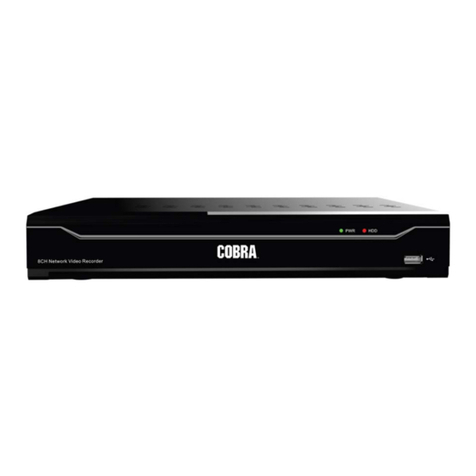
Cobra
Cobra 57648 Owner's manual & safety instructions

DSC
DSC Envoy NT9010 installation guide
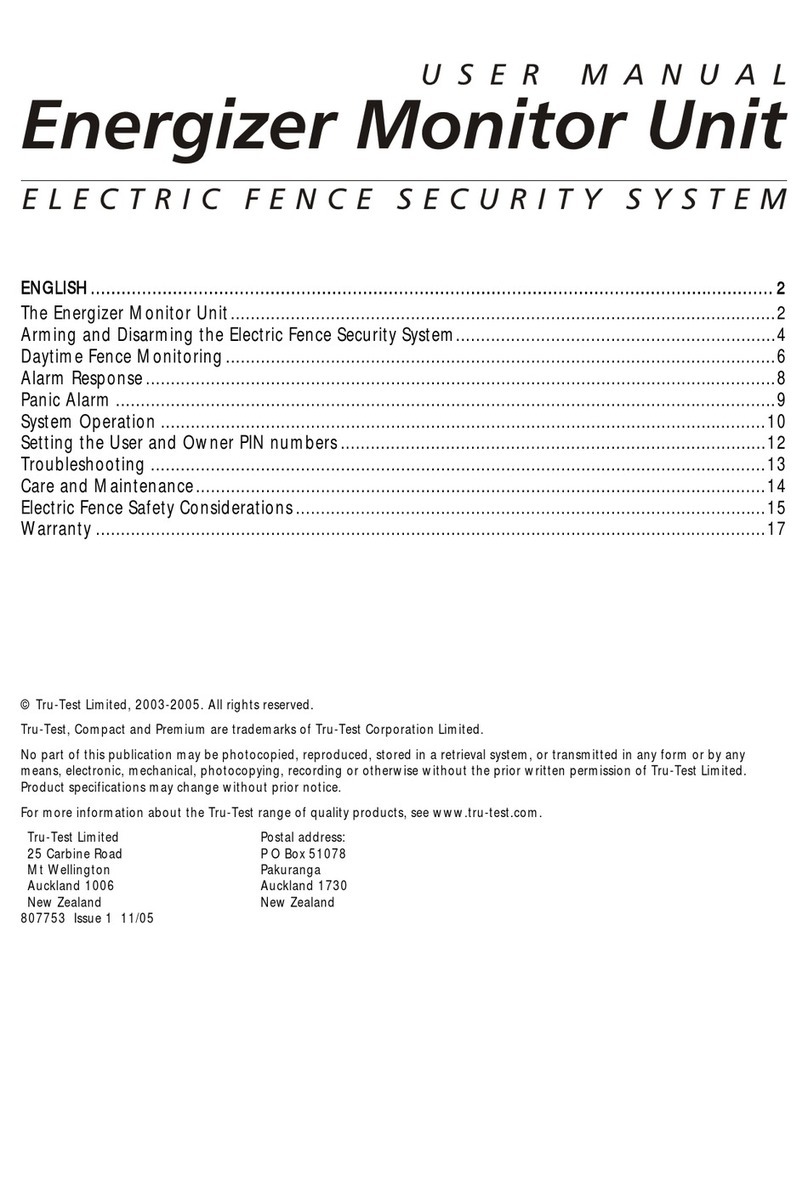
Tru-Test
Tru-Test Electric Fence Security System user manual
Electronics Line
Electronics Line iconnect user manual

Haztec
Haztec EconoMax 8-6400 quick start guide

Hugo Müller
Hugo Müller KNX AS 10.00 instruction manual
